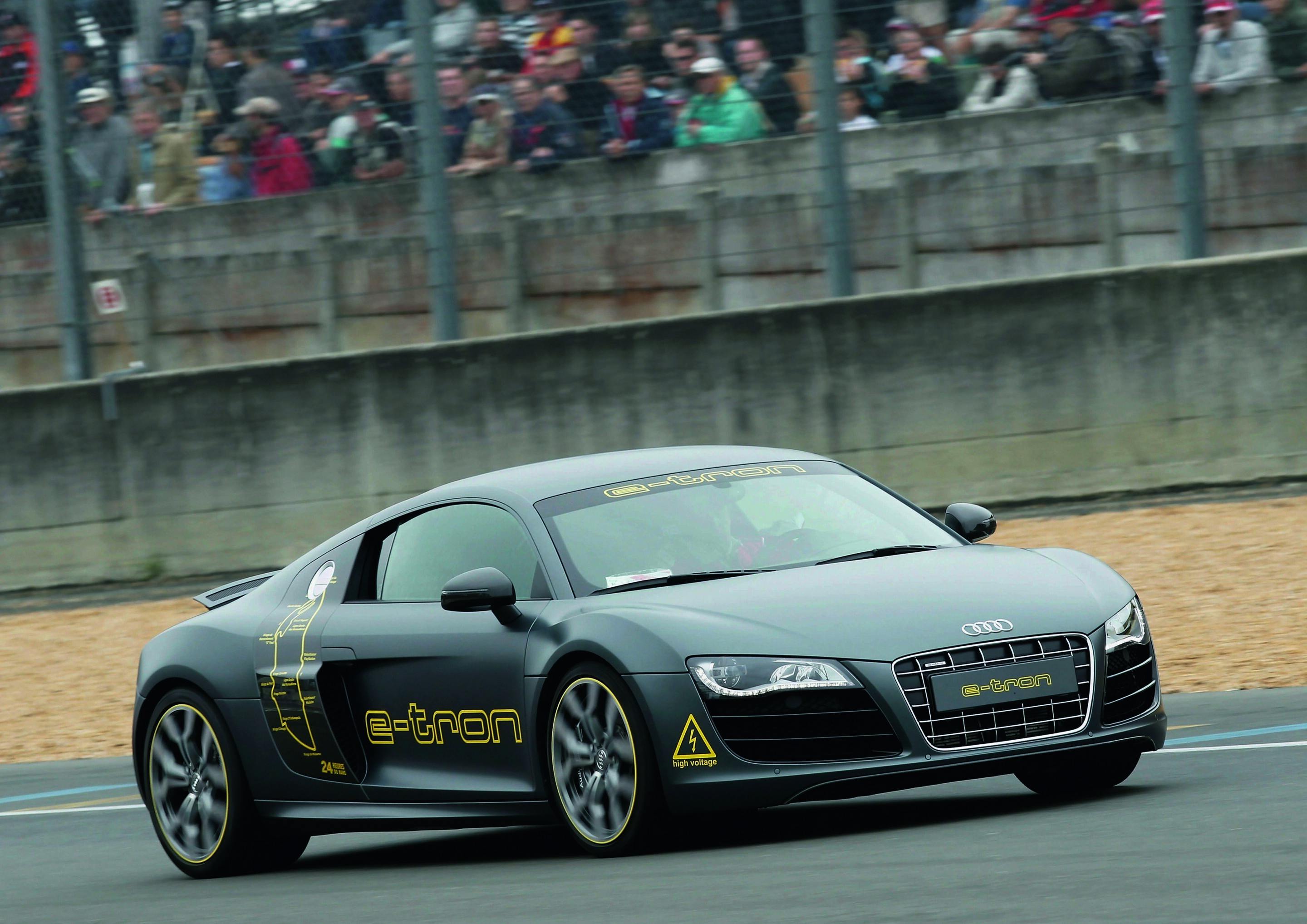Audi e-tron at 24 Hours of Le Mans
- Technology platform opens the 24-hour race
- Five-time Le Mans winner Frank Biela at the wheel of the Audi e-tron
- Le Mans vers le futur shows Audi concept for an electric sports car
Audi presents an Audi e-tron technology platform based on the R8 at the most important sports car race of the year. Racing legend
Frank Biela drove the purely electric powered high-performance sports car during the Le Mans vers le futur, a demonstration run for electric vehicles, giving Audi fans at the 24 Hours of Le Mans a peek at the fascinating future sporty electric cars.
Not one, but four motors – two each on the front and rear axles – power the wheels of the Audi e-tron, making the test vehicle a true quattro. With 230 kW (313 hp) and 4,500 Nm (3,319 lb-ft) of torque, the two-seater accelerates from 0 to 100 km/h (62.14 mph) in 4.8 seconds.
The test vehicle wrapped in the skin of an R8 demonstrates that the Audi e-tron belongs in the major leagues of electric sports cars. The package does justice to all of the specific realities of an electric vehicle: The battery is located directly behind the passenger cabin for an optimal center of gravity and axle load distribution.
The requirement specification for the production concept goes far beyond battery technology and the replacement of a combustion engine with an electric drive system. The interaction of all components has a decisive influence on efficiency, range and practicality. With the technology platform shown at Le Mans, Audi is providing an insight into the development work.
Design and package
The caliber of the car is apparent to the fans in Le Mans at first glance: Based on the R8, this Audi e-tron has a wide, powerful road stance. The trapeze of the single-frame grille dominates the front end and is flanked by two large air intakes.
1.90 meters (6.23 ft) wide while only 4.43 meters (14.53 ft) long and 1.25 meters (4.1 ft) tall – those are the proportions of a supercar. The wheelbase of 2.65 meters (8.69 ft) leaves ample room between the axles for people and technology. The sporty proportions offer enough room in front of the rear axle for the battery unit and the power electronics.
The special package of the Audi e-tron technology platform provides a 42:58 weight distribution between the front and rear axles and therefore ensures perfect balance and driving dynamics.
Systematic lightweight construction is a crucial prerequisite for efficiency and range – and this is also the case for electric vehicles. The Audi development engineers therefore draw on a core competence of the company for the e-tron. The body structure is based on Audi Space Frame (ASF) technology.
Driving dynamics
The normal distribution of the tractive power is clearly biased toward the rear axle. Similar to with a mid-engine sports car, roughly 70 percent of the power goes the rear and 30 percent to the front. If an axle slips, this balance can be varied by means of the four centrally controlled electric motors. The electric vehicle from Audi thus enjoys all of the advantages of quattro technology.
Via the four individual motors, which are each connected directly to the respective wheel via a short shaft, the e-tron also controls the lateral dynamics. Similar to the sport differential in conventional quattro vehicles, these motors allow torque vectoring – the targeted acceleration of individual wheels and thus an active distribution of tractive power. This boosts driving dynamics while simultaneously enhancing driving safety. Understeer and oversteer can be corrected by not only targeted activation of the brakes, but also by precise increases in power lasting just a few milliseconds. The concept car remains extremely neutral even under great lateral acceleration and hustles through corners as if on the proverbial rails.
The chassis has triangular double wishbones at the front axle and a trapezoidal-link rear suspension made of forged aluminum components – a geometry that has proven in motorsports to be the optimal prerequisite for high agility, uncompromising precision and precisely defined self-steering behavior. A taut setup was chosen for the springs and shock absorbers, but still offers a high level of comfort.
The direct rack-and-pinion steering gives finely differentiated feedback. Its electromechanical steering boost varies with speed. Fittingly, the technology platform rolls on 19-inch wheels.
Energy supply
The energy storage unit is charged with household current (230 volts/16 amperes) via a cable and a plug. The socket is behind what used to be the fuel cap. With the battery fully discharged, charging time is between six and eight hours. High-voltage (400 volts, 63 amperes) reduces this to around 2.5 hours.
The battery isn’t only charged when the car is stationary, but also while driving. They keyword here is recuperation. This form of energy recovery and return to the battery is already available today in a number of Audi production models. During braking, the alternator converts the kinetic energy into electrical energy, which it then feeds into the onboard electrical system.
Interior and control concept
The interior evokes a luxury-grade racing atmosphere. As in the R8, its distinguishing characteristic is the monoposto – a large arc that sweeps around the instruments. Unlike the production R8, however, the Audi e-tron has a graphic display for indicating the driving mode located between two round-dial instruments showing the recuperation and boost level.
Similar to the new A8, the driver of this high-performance sports car can select the various driving modes using a stalk that is based on shift-by-wire technology.
